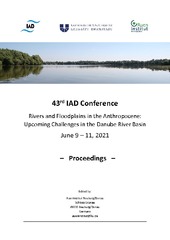Приказ основних података о документу
Non-wild type antibiotic resistant Escherichia coli in the River Danube: a six-year-comparison
| dc.contributor | Sandu, Cristina | |
| dc.contributor | Cyffka, Bernd | |
| dc.creator | Koller, Michael | |
| dc.creator | Hack, Kerstin | |
| dc.creator | Dielacher, Irina | |
| dc.creator | Wachter, Julian | |
| dc.creator | Schachner, Iris | |
| dc.creator | Jakwerth, Stefan | |
| dc.creator | Kolarević, Stoimir | |
| dc.creator | Kračun-Kolarević, Margareta | |
| dc.creator | Tóth, Erika | |
| dc.creator | Savio, Domenico | |
| dc.creator | Farnleitner, Andreas H. | |
| dc.creator | Kittinger, Clemens | |
| dc.creator | Kirschner, Alexander K.T. | |
| dc.creator | Zarfel, Gernot | |
| dc.date.accessioned | 2022-01-19T13:51:33Z | |
| dc.date.available | 2022-01-19T13:51:33Z | |
| dc.date.issued | 2021 | |
| dc.identifier.uri | http://radar.ibiss.bg.ac.rs/handle/123456789/4730 | |
| dc.description.abstract | Introduction The emerging occurrence of human induced antibiotic resistant bacteria (ARB) is not only limited to clinical surroundings: they can also be found in the human population, animals and the water environment. Large rivers are of great concern as regards the spreading of ARB. Thus, this ongoing study ́s aim is to analyze the major propagation pathways and sources of ARB in the Danube, and to do a six-year-comparison with data obtained in 2013. Study design and methods Within the frame of the 4th Joint Danube Survey (JDS) of the International Commission for the Protection of the Danube River (ICPDR), water samples were taken at 36 sampling points along the whole Danube. Escherichia coli as clinically relevant organisms were isolated and tested for their susceptibility to 20 different antibiotics. Results 1298 E. coli isolates have been tested so far. 11.33 % of them were multiresistant and 23.19 % were resistant to one or two classes of antibiotics. The preliminary data show a very similar pattern compared to the data obtained in 2013 (629 isolates) when 9.70 % of the isolates were multiresistant and 29.09 % were resistant to one or two classes of antibiotics. Most of the resistances are still to ampicillin and tetracycline. There are no resistances to carbapenems, colistin, amikacin and tigecycline. But there is a significant increase in resistances to amoxicillin with clavulanic acid, moxifloxacin and piperacillin with tazobactam and a significant decrease regarding tetracycline. 21 isolates are confirmed ESBL-producers while in 2013 there were four. Discussion In comparison the data of 2013 and 2019 show a similar pattern regarding multiresistance. Regarding resistances to single antibiotics significant changes could be determined. However, there are still many of the isolates to be tested until the final analysis. | sr |
| dc.language.iso | en | sr |
| dc.publisher | Neuburg: Aueninstitut Neuburg | sr |
| dc.rights | openAccess | sr |
| dc.source | 43rd IAD Conference: Rivers and Floodplains in the Antropocene: Upcoming Challenges in the Danube River Basin | sr |
| dc.title | Non-wild type antibiotic resistant Escherichia coli in the River Danube: a six-year-comparison | sr |
| dc.type | conferenceObject | sr |
| dc.rights.license | ARR | sr |
| dc.rights.holder | © 2021 by the Aueninstitut Neuburg | sr |
| dc.description.other | Sandu C, Cyffka B, editors. Proceedings: 43rd IAD Conference: Rivers and Floodplains in the Anthropocene: Upcoming Challenges in the Danube River Basin; 2021 Jun 9-11; Neuburg, Germany. 2021. p. 30. | sr |
| dc.citation.spage | 30 | |
| dc.type.version | publishedVersion | sr |
| dc.identifier.fulltext | https://radar.ibiss.bg.ac.rs/bitstream/id/9745/43rd_IAD_Conference_Proceedings_30.pdf | |
| dc.citation.rank | M34 | |
| dc.identifier.rcub | https://hdl.handle.net/21.15107/rcub_ibiss_4730 |

